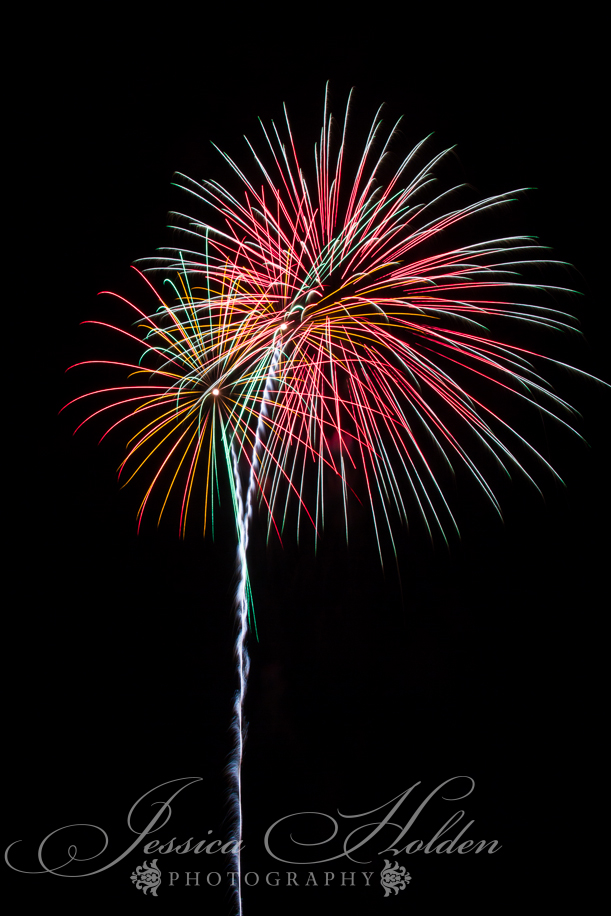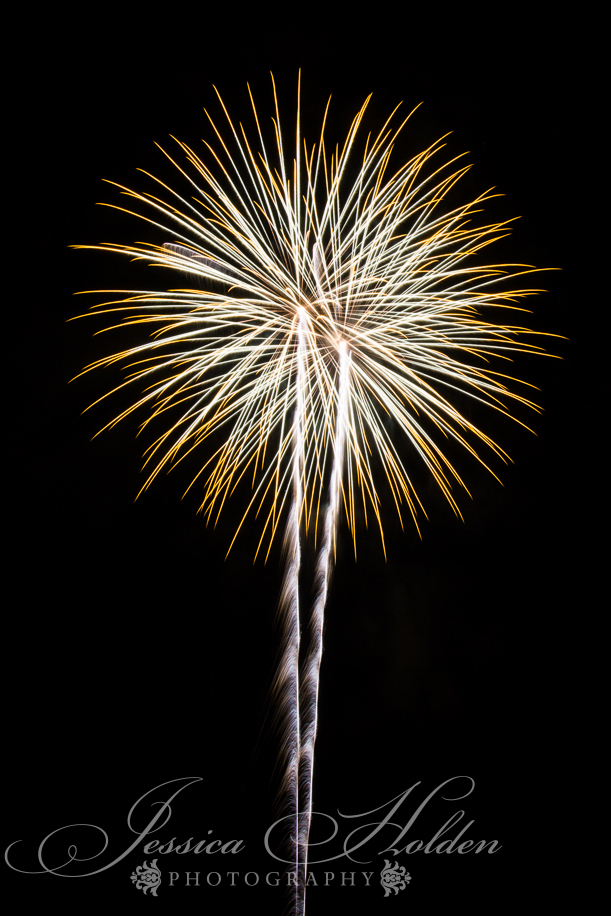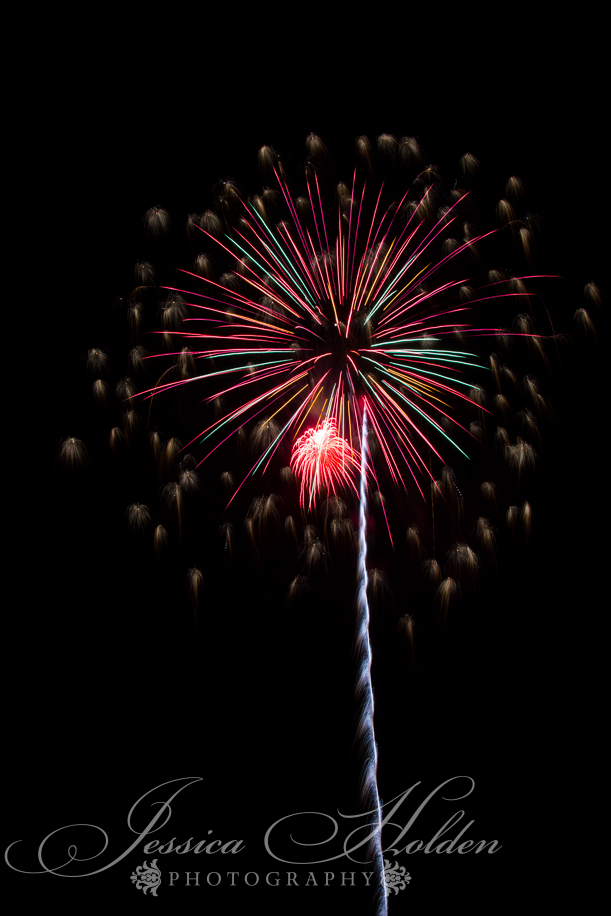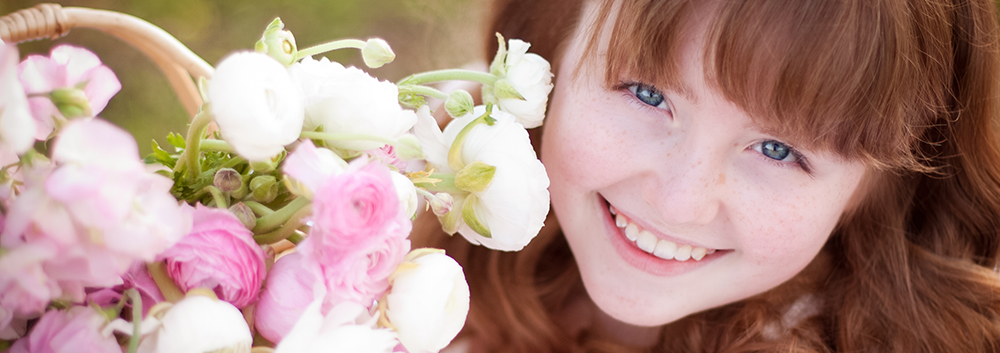

It had been on my photography bucket list for a long, long time: Get a good shot of fireworks, one with those beautifully clean, lovely trails of light cascading down in the darkness. I was fascinated, but my first few tries were definitely flops! So I decided to write up a post to help others get there faster, without the trial and error. Especially since with fireworks you often don’t have a lot of time to get it right, and some of us only get to see one show a year!


There’s an amusement park sort of near us that shows fireworks several times a year, so I decided it give it a try a couple of years ago. We pulled into a parking lot to watch, but that first time I didn’t have a tripod. Naïvely, I thought I might be able to shoot them without a tripod if I could find something to brace my camera on, like the hood of a car. However, I’ve come to the conclusion that a tripod is pretty crucial. If you can’t use one, at the very least you need to set your camera down on a completely solid surface, and use either a remote or your camera’s timer (I set it at 2 seconds for this so I didn’t have to keep waiting for the longer delay). The timer or remote are important to eliminate even the slight camera shake that might be caused by pushing and releasing the shutter button.
The other problem with my first try was our location—there was too much ambient light from the lights of the parking lot we were in, and we were too close to trees. Situating yourself in a darker area will work best, and trees need to be further away than you would think; fireworks are high up, of course, but even though the trees were about 100 yards away from us, at times they still blocked the action that was happening lower on the horizon and it kind of ruined many shots.
That first night I learned a lot, but didn’t get anything I was thrilled with so we set out to try again on another night. This time we chose a different parking lot that was a bit closer to the action and was also darker and with no nearby trees, and we settled ourselves along the edge where the lights were minimal and all behind us. And this time I brought my tripod! I still used the 2-second timer to avoid even the slightest camera shake, but a remote would have been even better so I could actually control when the shutter was tripped, depending on what I wanted to capture. When using the timer I have to try to predict the right moments including the 2-second delay, and it was hit or miss. I used the spray and pray method of shooting, meaning that I just kept hitting the shutter button constantly hoping to get images when the bursts were at their peak.


After much trial and error, I set my ISO down to 100 (since your shutterspeed will be very slow to catch the trails, you really need to use “fast film” so that your sky will stay nice and black), and then I closed up my aperture to 20 or 22 (partly to keep the depth of field great enough for everything to be sharp, and partly because again you need to restrict the amount of light that will affect the overall brightness of your images), depending on my SS. Then I took a shot and chimped (checked my exposure by looking at the image on the LCD), adjusting as needed. A zoom lens that can shoot wide angles (I used my Tamron 28-300 because it’s the widest lens I own) can be helpful too so you can zoom in and out depending on how much of the frame you want to fill and how big the show is, but if you don’t have a wide zoom, I’d take the widest lens you have.
For most of the images in this post the focal length was 28, the ISO 100, the shutterspeed 6 seconds, and the aperture f/20. (For the last image, I changed my aperture to f/22 and the shutterspeed of 10 seconds, so I could try to get the bulk of the their finale—that ended up being a little bright, but f/22 and ISO 100 is the lowest I could go on inhibiting light coming in with that lens, but I really wanted the long shutterspeed, so I had to pull the exposure back a bit in post.).


For editing these images, it really doesn’t take much! I like to pull up the blacks to darken the sky, and I increase the saturation and maybe the contrast a bit to make them pop. Since you won’t be moving around much and your subject is unpredictable (especially since you’ll be tripping the shutter before you know precisely where the action is happening for each burst), you’ll likely also need to crop a bit to get the best composition. Then sharpen as you normally would, and you’re done!


Next on my list? Someday I’d love to find a place where I can get shots similar to this, but with water in the foreground that reflects the fireworks. Think that might be too tall an order? I hope not! There are not a lot of lakes around where I live, but I still hope maybe one day I will be able to manage it!


.jpg)
.png)
.jpg)